#when I say this dual portrait has been haunting me
Explore tagged Tumblr posts
Text
Me @ me:
Hey. Hey. Look at me. Looook me in the eyes. You wanna finish something this week? That portrait, maybe, that you’ve been procrastinating adding a mouth to for WEEKS? Or one of the stories. Any of them. Pick one. Just maybe. Just sit still and commit. Look at me. Look. I am begging you.
#when I say this dual portrait has been haunting me#I go in. I sit at the desk. I adjust the nose. I start the mouth.#I erase the mouth. I throw my pencil. I leave the office.#something this week man. a story at the VERY least. I have Hopes#slim. slim. hopes.
11 notes
·
View notes
Text
BLOGTOBER 10/7/2020
I missed THE GOLDEN GLOVE at Fantastic Fest last year. It was one of my only regrets of the whole experience, but it was basically mandatory since the available screenings were opposite the much-hyped PARASITE. As annoying as that sounds, it was actually a major compliment, since what could possibly serve as a consolation prize for the most hotly anticipated movie of the year? Needless to say, I heard great things, but I could never have imagined what it was actually like. I'm still wrapping my mind around it.
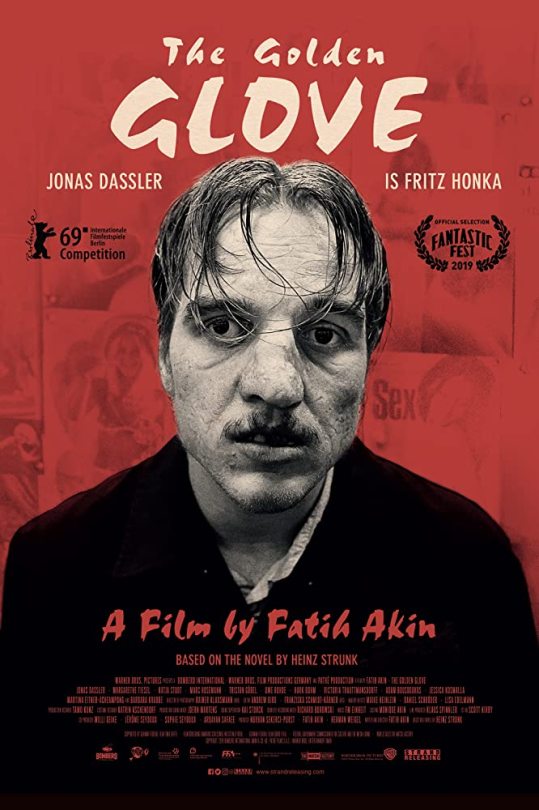
Between 1970 and 1975, an exceptionally depraved serial killer named Fritz Honka murdered at least four prostitutes in Hamburg's red light district. Today, we tend to think of the archetypal serial killer in terms of ironic contradictions: The public is attracted by Ted Bundy's dashing looks and suave manner, and John Wayne Gayce's dual careers as politician and party clown. Lacking anything so remarkable, we associate psychopathy with Norman Bates' boy-next-door charm, and repeat "It's always the quiet ones" with a smirk whenever a new Jeffrey Dahmer or Dennis Nilsen is exposed to the public. The popular conception of a bloodthirsty maniac is not the fairytale monster of yore, but a wolf in sheep's clothing, whose hygienic appearance and lifestyle belie his twisted desires. In our post-everything world, the ironic surprise has become the rule. In this light, THE GOLDEN GLOVE represents a refreshing return to naked truth.

To say that writer-director Fatih Akin's version of the Fritz Honka story is shocking, repulsive, and utterly degenerated would be a gross understatement. We first meet the killer frantically trying to dispose of a corpse in his filthy flat, wallpapered with porno pinups, strewn with broken toys, and virtually projecting smell lines off of the screen. One's sense of embodiment is oppressive, even claustrophobic, as the petite Honka tries and fails to collapse the full dead weight of a human corpse into a garbage bag, before giving up and dismembering it, with nearly equal difficulty. The scene is appalling, utterly debased, and yet nothing is as shocking as the killer's visage. When he finally turns to look into the camera, it's hard to believe he's even human: the rolling glass eye, the smashed and inflated nose, the tombstone teeth and cratered skin, are almost too extreme to bear. Actually, suffering from a touch of facial blindness, I had to stare intently at Honka's face for nearly half the movie before I could fully convince myself that I was, in fact, looking at an elaborate prosthetic operation used to transform 23 year old boy band candidate Jonas Dassler into the disfigured 35 year old serial murderer.

Though West Germany remained on a steady economic upturn beginning in the 1950s and throughout the 1970s, you wouldn't know it from THE GOLDEN GLOVE. If Honka's outsides match his insides, they are further matched by his stomping grounds in the Reeperbahn, a dirty, violent, booze-soaked repository for the dregs of humanity. Though its denizens may come from different walks of life, one thing is certain: Whoever winds up there, belongs there. Honka was the child of a communist and grew up in a concentration camp, yet he swills vodka side by side with an ex-SS officer, among other societal rejects, in a crumbling dive called The Golden Glove. The scene is an excellent source of hopeless prostitutes at the end of their career, who are Honka's prime victims, as he is too frightful-looking to ensnare an attractive young girl. These pitiful women all display a peculiarly hypnotic willingness to go along with Honka, no matter how sadistic he becomes; this seems to have less to do with money, which rarely comes up, and more to do with their shared awareness that for them, and for Honka too, it's been all over, for a long time.

Not to reduce someone’s performance to their physical appearance, but ???
To call Dassler's portrayal of Honka "sympathetic" would be a bridge too far, but it is undeniably compelling. He supports the startling impact of his facial prostheses with a performance of rare intensity, a full-body transformation into a person in so much pain that a normal life will never become an option. His physical vocabulary reminded me of the stage version of The Elephant Man, in which the lead actor wears no makeup, but conveys John Merrick's deformities using his body alone. Although there is an abundance of makeup in THE GOLDEN GLOVE, Dassler's silhouette and agonized movements would be recognizable from a mile away. In spite of his near-constant screaming rage, the actor manages to craft a rich and convincing persona. During a chapter in which Honka experiments with sobriety, we find a stunning image of him hunched in the corner of his ordinarily chaotic flat, now deathly still, his eyes gazing at nothing as cigarette smoke seeps from his pores, having no idea what to do with himself when he isn't in a rolling alcoholic rampage. The moment is brief but haunting in its contrast to the rest of the film, having everything to do with Dassler's quietly vibrating anxiety.
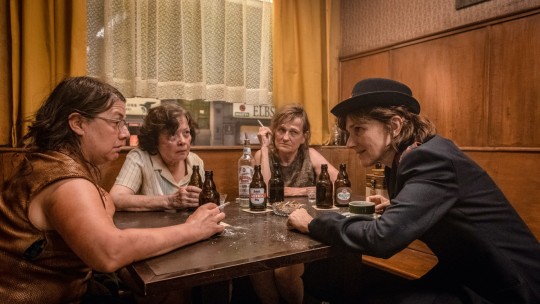
Performances are roundly excellent here, not that least of which are from Honka's victims. The cast of middle-aged actresses looking their most disastrous is hugely responsible for the film's impact. These are the kinds of performances people call "brave", which is a euphemism for making audiences uncomfortable with an uncompromising presentation of one's own self, unvarnished by any masturbatory solicitation. Among these women is Margarete Tiesel, herself no stranger to difficult cinema: She was the star of 2012's PARADISE: LOVE, a harrowing drama about a woman who copes with her midlife crisis by pursuing sex tourism in Kenya. Her brilliant, instinctive performance as one of Honka's only survivors--though she nearly meets a fate worse than death--makes her the leading lady of a movie that was never meant to have one.

So, what does all this unpleasantness add up to, you might be asking? It's hard to say. THE GOLDEN GLOVE is a film of enormous power, but it can be difficult to explain what the point of it is, in a world where most people feel that the purpose of art is to produce some form of pleasure. This is the challenge faced by difficult movies throughout history, like THE GOLDEN GLOVE's obvious ancestors, HENRY: PORTRAIT OF A SERIAL KILLER, MANIAC and THE TEXAS CHAIN SAW MASSACRE. Describing unremitting cruelty with relentless realism is not considered a worthy endeavor by many, even if there is real artistry in your execution; some people will even mistake you for advocating and enjoying violence and despair, as we live in a world where huge amount of movie and TV production is devoted to aspirational subjects. (The fact that people won't turn away from the Marvel Cinematic Universe movies, no matter how monotonous and condescending they become, should tell you something) How do you justify to such people, that you want to make or see work that portrays ugliness and evil with as much commitment as other movies seek to portray love, beauty, and family values? Why isn't it enough to say that these things exist, and their existence alone makes them worth contemplation?

A rare, perhaps exclusive “beautiful image” in THE GOLDEN GLOVE, from Fritz Honka’s absurd fantasies.
You may detect that I have attempted to have this frustrating conversation with many people, strangers, enemies, and friends I love and respect. I find that for some, it is simply too hard to divorce themselves from the pleasure principle. I don't say this to demean them; some hold the philosophy that art be reserved for beauty, and others have a more literary feeling that it's ok to show characters in grim circumstances, as long as the ultimate goal is to uplift the human spirit. Even I draw the line somewhere; I appreciate the punk rebellion of Troma movies as a cultural force, but I do not enjoy watching them, because I dislike what I perceive as contempt for the audience and the aestheticization of laziness--making something shitty more or less on purpose. A step or three up from that, you land in Todd Solondz territory, where you find materially gorgeous movies whose explicit statement is that our collective reverence for a quality called "humanity" is based on nothing. I like some of those movies, and sometimes I even like them when I don't like them, because I'm entranced by Solondz's technical proficiency...and maybe, deep down, I'm not completely convinced about "humanity", either. However, I don't fight very hard in arguments about him; I understand the objections. Still, I've been surprised by peers who I think of as bright and tasteful, who absolutely hated movies I thought were unassailable, like OLDBOY and WE NEED TO TALK ABOUT KEVIN. In both cases, the ultimate objection was that they accuse humans of being pretentious and self-deceptive, aspiring to heroism or bemoaning their victimhood while wallowing in their own cowardice and perversity. Ok, I get it...but, not really. Why isn't it ever wholly acceptable to discuss, honestly, what we do not like about ourselves?
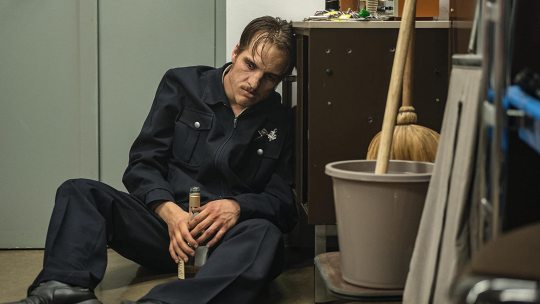
The beguiling thing about THE GOLDEN GLOVE is that, although it is instantly horrifying, is it also an impeccable production. The director can't help showing you crime scene photos during the ending credits, and I can't really blame him, when his crew worked so hard to bring us a vision of Fritz Honka's world that approaches virtual reality. But it isn't just slavishly realistic; it is vivid, immersive, an experience of total sensory overload. Not a square inch of this movie has been left to chance, and the product of all this graceful control is totally spellbinding. I started to think to myself that, when you've achieved this level of artifice, what really differentiates a movie like THE GOLDEN GLOVE from something like THE RED SHOES? I mean, aside from their obvious narrative differences. Both films plunge the viewer into a world that is complete beyond imagination, crafted with a rigor and sincerity that is rarely paralleled. And, I will dare to say, both films penetrate to the depths of the human soul. What Fatih Akin finds there is not the same as what Powell and Pressburger found, of course, but I don't think that makes it any less real. Akin's film is adapted from a novel by Heinz Strunk, and apparently, some critics have accused Akin of leaving behind the depth and nuance of the book, to focus instead on all that is gruesome about it. This may be true, on some level; I wouldn't know. For now, I can only insist that on watching THE GOLDEN GLOVE, for all its grotesquerie, I still got the message.
#blogtober#2020#the golden glove#fatih akın#heinz stronk#jonas dassler#margarete tiesel#difficult cinema#horror#slasher#serial killer#period piece#adaptation#historical#biopic#fritz honka#i may have been watching a lot of powell and pressburger movies recently#sorry...
23 notes
·
View notes
Text
The Director’s Series: Andrei Tarkovsky
The director series will consist of me concentrating on the filmography of all my favorite directors. I will rank each of their films according to my personal taste. I hope this project will provide everyone with quality recommendations and insight into films that they might not have known about. Today’s director in spotlight is Andrei Tarkovsky
#7 - Ivan’s Childhood (1962) Runtime: 1 hr 35 min Aspect Ratio: 1.37 : 1 Film Format: 35mm

Poetic journey through the shards and shadows of one boy’s war-ravaged youth. Verdict: About as poetic a cinematic debut that you will ever likely come across in foreign cinema. Tarkovsky lays the foundation of the rest of the career with Ivan’s Childhood with his signature long takes, poetic musings, and quiet spirituality. It comes off as a stream of consciousness retelling of a boy’s memories as he is thrust into a hopeless war. It’s the one Tarkovsky film I don’t revisit often, but an important contribution to his body of work nonetheless.
#6 - The Sacrifice (1986) Runtime: 2 hr 29 min Aspect Ratio: 1.66 : 1 Film Format: 35mm

Alexander, a journalist, philosopher and retired actor, celebrates a birthday with friends and family when it is announced that nuclear war has begun.
Verdict: The Sacrifice was Tarkovsky’s final film - released just shortly before his death from lung cancer. And it’s a swan song if there ever was any. The maestro somehow masterfully takes a culmination of themes, ideas and moods from all his previous six films and blends them into an “end of the world” tale that’s never been told in such a fashion. The Sacrifice contains some of Tarkovsky’s most philosophical and religiously charged dialogue. Andrei’s commitment to emotion before logic is always an admirable feat.
#5 - Nostalghia (1983) Runtime: 2 hr 5 min Aspect Ratio: 1.66 : 1 Film Format: 35mm

The Russian poet Andrei Gorchakov, accompanied by guide and translator Eugenia, is traveling through Italy researching the life of an 18th-century Russian composer. In an ancient spa town, he meets the lunatic Domenico, who years earlier had imprisoned his own family in his house for seven years to save them from the evils of the world. Seeing some deep truth in Domenico’s act, Andrei becomes drawn to him. In a series of dreams, the poet’s nostalgia for his homeland and his longing for his wife, his ambivalent feelings for Eugenia and Italy, and his sense of kinship with Domenico become intertwined. Verdict: I view Nostalghia as Tarkovsky’s biggest cry of pain as an artist, and possibly his most personal work. It’s a cry of shattered memories from a homeland in which you no longer feel belongs to you. Andrei was exiled from the Soviet Union due to his creative tendencies coming off as a threat from the government who tried to control creative expression. The story of this film mirrors his own circumstance and it’s a deeply moving insight into what society considers madness and what society considers normal - and the blurry line in which people create while making these differentials.
#4 - Stalker (1979) Runtime: 2 hr 42 min Aspect Ratio: 1.37 : 1 Film Format: 35mm

Near a gray and unnamed city is the Zone, a place guarded by barbed wire and soldiers, and where the normal laws of physics are victim to frequent anomalies. A stalker guides two men into the Zone, specifically to an area in which deep-seated desires are granted.
Verdict: One out of two films from Andrei’s work which could hold the only title as pure “philosophical sci-fi”. It’s such a breath of fresh air in comparison to other popular entries within the genre for the simple fact that Stalker seems to have a real soul and a real pulse to be found within the roots of the storytelling. It’s a story about the deepest most subconscious desires of the soul, and the resistance to these desires coming into fruition when the opportunity is offered. It’s about the conflicting forces that exist within our soul. Dark fighting light, and light fighting dark, until the two merge into union. Stalker is a haunting portrait of men traversing to the darkest places both physically and mentally in search of what was in front of them the entire time.
#3 - Andrei Rublev (1966) Runtime: 3 hr 3 min Aspect Ratio: 2.35 : 1 Film Format: 35mm

An expansive Russian drama, this film focuses on the life of revered religious icon painter Andrei Rublev. Drifting from place to place in a tumultuous era, the peace-seeking monk eventually gains a reputation for his art. But after Rublev witnesses a brutal battle and unintentionally becomes involved, he takes a vow of silence and spends time away from his work. As he begins to ease his troubled soul, he takes steps towards becoming a painter once again.
Verdict: Andrei Rublev takes the spot as Tarkovsky’s longest and most expansive film. It is epic not only just for its scope, but also for its ambitious themes and ideas. To think that this was the director’s second attempt at a feature film is almost incomprehensible (it’s that good). This is huge step up in quality in relation to his more minimalist debut with Ivan’s Childhood. Andrei Rublev is when Tarkovsky started to experiment more with his signature style: arresting images, long takes, and an enhanced focus on sound design. It’s also the auteur’s most religious and historical work. Scenes such as the Pagans being hunted by the Christians, and the Tatar invasion of the village, are absolutely sublime. The acts we are witnessing are savage and brutal, but Tarkovsky’s framing and visual expertise make them nothing short of beautiful.
#2 - Mirror (1975) Runtime: 1 hr 47 min Aspect Ratio: 1.37 : 1 Film Format: 35mm & 16mm

A dying man in his forties recalls his childhood, his mother, the war and personal moments that tell of and juxtapose pivotal moments in Soviet history with daily life.
Verdict: Recalling memories isn’t always the easiest thing. We don’t always remember the most specific details in regards to time or location. But they always seem to leave a specific flavor in our mouths, or a specific scent in the air. Memories, just like Tarkovsky’s films, are oftentimes meant to be “felt” more than they are meant to be “understood” on a logical level. Tarkovsky takes the near impossible feat of conveying the language of memories and created a perfect piece of art that both reflected the inner turmoil of his own soul, but also a lot of innate fears and desires of any human who experiences a lifetime on this planet. It’s as if Tarkovsky knew of his own doomed fate ten years previous to his actual demise with Mirror. The end result is a montage of scenes from the director’s adulthood and childhood. Fact and fiction are blended, just like the actors who play dual roles within the story. Mirror has grown on me more than any Tarkovsky film over the years, and is one of the most soul stirring portrayals of human life and death that I have ever seen in a film.
#1 - Solaris (1972) Runtime: 2 hr 47 min Aspect Ratio: 2.35 : 1 Film Format: 35mm

A psychologist is sent to a space station orbiting a planet called Solaris to investigate the death of a doctor and the mental problems of cosmonauts on the station. He soon discovers that the water on the planet is a type of brain which brings out repressed memories and obsessions.
Verdict: I sometimes feel like a “Tarkovsky newbie” when I confess that Solaris is my favorite of his work, especially considering Andrei himself regarded it as one of his lesser works. I am by no means saying that Solaris is Tarkovsky’s best film, but for me, it is simply my most favorite and the one that I have revisited the most often. Maybe it’s because it was the first Tarkovsky film I ever saw and it struck such a strong cord within myself. However I think it’s even more so that it’s a space exploration film that was never, and still has never, been surpassed in its spiritual and emotional intelligence. Coming out only just a few years after 2001: A Space Odyssey, Tarkovsky’s Solaris feels more like a distant cousin than it does its opposite. However Solaris, unlike 2001, is more organic than it is mechanical and is more emotional than it is objective or scientific. What if a planet truly was conscious? What if that planet could materialize a previously deceased animal or person who meant the entire world to you? These are some of the ideas that are at play in Solaris and it ends up being an examination of identity and consciousness. The organ-heavy score stirs up an unfounded nostalgia within myself. It’s score and soundscapes transport me to a place that I feel like I have been before in a long lost life. The ending shot doesn’t fail to send shivers down my spine in its poetic ambiguity.
#the director's series#favorite directors#cinema#andrei tarkovsky#russian cinema#soviet union#solaris#stalker#offret#the sacrifice#mirror#zerkalo#ivan's childhood#2001: A Space Odyssey#nostalghia#andrei rublev#poetry#philosophy#religion#tarkovsky
89 notes
·
View notes
Text
TOP 20 ROCK/METAL ALBUMS OF 2018
This has been a year of surprises and disappointments in pretty equal measure. Judas Priest blew me away with their latest record (and tour) and Immortal made one of the most triumphant comebacks in metal history. On the other hand, Voivod’s new one felt strangely by-the-numbers, as did the latest from Riot V and Monster Magnet. Still, the sheer amount of releases out there, just in the traditional metal and thrash scenes, is somewhat mind-boggling, and there were plenty of excellent albums to be found.
(Countries represented this year: Italy, UK, Sweden, Norway, Germany, USA, Canada, Switzerland, Portugal, and Denmark).
20. BURNING WITCHES - Hexenhammer
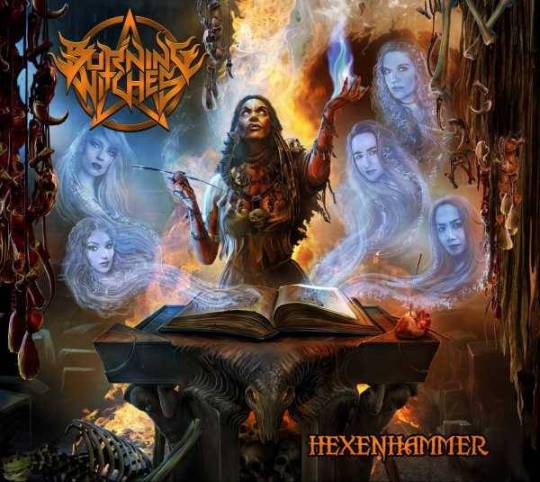
Switzerland is a tiny nation, but they have given the world some of the most creative and diverse bands over the years, from Krokus to Celtic Frost to Samael and beyond. Burning Witches combine elements of melodic thrash and classic heavy metal for a sound that works quite well and is perfectly suited to Seraina Telli’s powerful vocal delivery. The album has its ups and downs but the title track and “Open Your Mind” are both flat-out brilliant.
19. PERPETRATÖR - Altered Beast

This is how I like my thrash metal: fast, evil, dirty, but still well-played and composed. Perpetratör hail from Portugal and this is only their second full album, but it is a scorcher. Songs like “Extreme Barbarity” and “Terminal Possession” are brutally fast in the vein of the early Germans, but the band explore some more mid-tempo riffs here and there as well. Like all my favorite thrash bands, these guys sound like they are playing just on the edge of what they can get away with and the effect is electric.
18. ARTILLERY - The Face of Fear
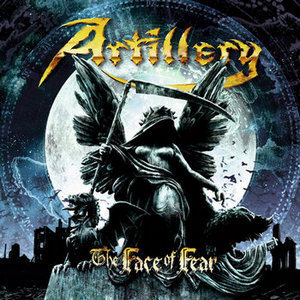
These Danish thrashers are one of those bands that has always had consistently quality releases but, for whatever reason, never really made the impact others in the genre have over the years. While the line-up has changed over time, the current incarnation has done three albums together now and sounds quite comfortable here. The drum sound is a bit ‘bonky’ for my tastes, but the quality of the tunes rises above it. Bonus points for the variety of songs on offer, too, from speedy, complex thrash, to power ballads to straight-ahead heavy metal.
17. LUCIFER - II
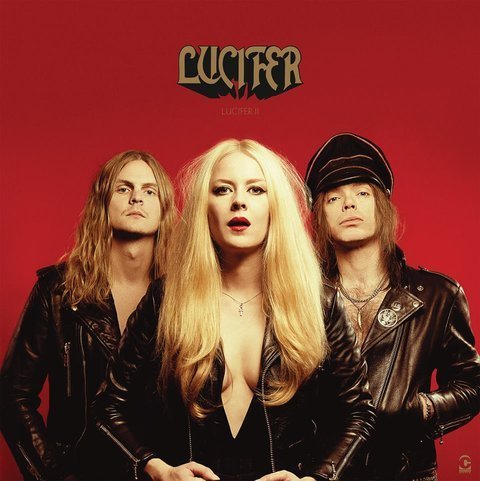
Lucifer’s brand of retro doom rock is both obvious in its influences and original in its assembly of said influences. The jazzier side of early Sabbath is the most prevalent element at work here, with riffs that range from heavy and evil to mournful and atmospheric. Despite some line-up changes, the sound is pretty consistent with the excellent debut from 2015, with perhaps a bit more clarity in the production (though nowhere near polished-sounding, fear not).
16. WITCHING HOUR - ...And Silent Grief Shadows the Passing Moon
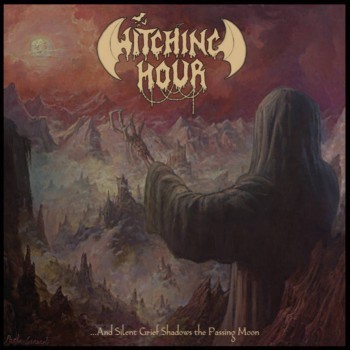
The number of excellent bands with ‘witch’ in their name is strangely high this year and Germany’s Witching Hour are another to add to that list. This is their third full-length and displays a great deal of maturity and talent for writing complex yet compelling songs. Elements of black and thrash metal abound, but there is a lot of other stuff going on here, too, and lots of melody. The bass playing is particularly impressive and really adds a whole extra dimension to the music, while the vocals are a potent mix of plaintive and grim and complement the dark, intricate songs beautifully. This was a late-year release and, given some more spins, it will likely rise on this list.
15. SATAN - Cruel Magic
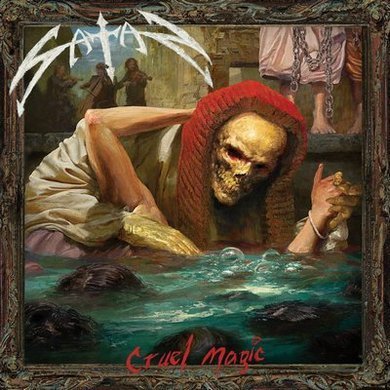
It is rare that a band can pull together their classic line-up the way that Satan did in 2013, let alone one that can then proceed to release three albums back-to-back that fall right in line with their old material. Cruel Magic is the latest of these and has all the hallmarks that made Satan great: finely-crafted heavy metal that is speedy and complex, organic production, and an overall sound that is truly their own. They may have only caught the tail-end of the NWOBHM but damn if they weren’t one of the scene’s best and it is heart-warming to see and hear them continuing the legacy 35 years later.
14. ABYSMAL GRIEF - Blasphema Secta
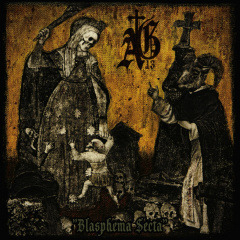
Abysmal Grief are Italian doom masters that create a sound that is heavy, gothic, creepy, and relentless all at once. Most songs are in the 8-9 minute range and are usually centered around a few core riffs, but the way the band build them up and vary them throughout really pulls the listener in. Keyboards are used quite a bit and to great effect, while the vocals range from mournful to menacing. The band has kept a very consistent style since day one, with only the production getting a little better with each release, and Blasphema Secta sounds both heavier and cleaner than anything prior.
13. STRIKER - Play to Win

Been following these stalwart Canucks since their debut EP a decade ago and I’m glad to see that they have continued to evolve and refine their sound with each new album. Play to Win is probably the most ‘commercial’ release to date, with tons of melody and big choruses, but there is still plenty of heaviness on tracks like “Heart of Lies” and “Summoner” to keep a nice balance. Striker has gotten really good at writing distinctive songs that aren’t just a collection of riffs but actual, well-constructed tunes.
12. BULLET - Dust to Gold
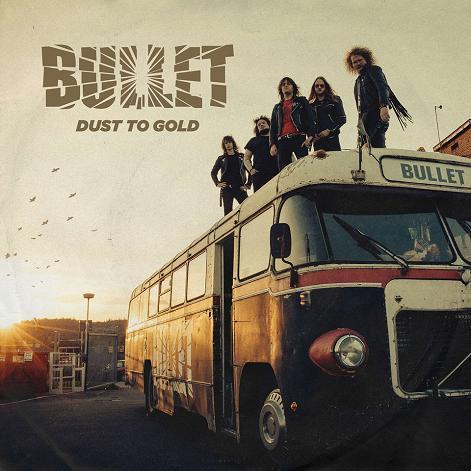
This Swedish quintet has been bashing it out for 15+ years and still manages to release an invigorating collection of hard rockin’ metal tunes. Stylistically, Dust to Gold covers a fair amount of ground, from heavy metal in the vein of Accept and Grave Digger to more upbeat rockers ala Krokus and AC/DC. The common denominator throughout is a sense of fun that is missing from entirely too many albums these days.
11. LEATHER - II
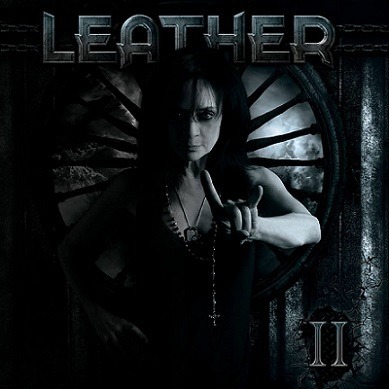
Leather’s powerful voice was always the thing that raised Chastain from a good band to a great one and I’m pleased to report that she sounds just as good in 2018 as she did in 1988. The opening track “Juggernaut” is one of the best speed metal songs I have heard in a while and the rest of the album is consistently good, too. Shades of Dio and Priest color the wide range of tunes here and the band turn in some excellent, spirited performances. Glad to see Leather back on the scene and, as much as I enjoyed the Chastain reunion records, I think this one is even better.
10. HAUNT - Burst Into Flame
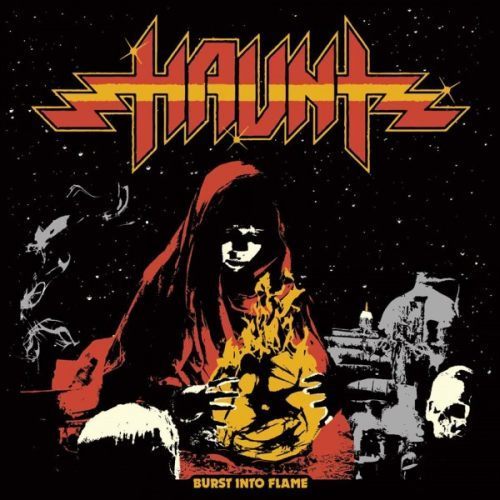
Although I enjoyed the first Haunt EP, the full-length debut really takes it up a notch. This is classic, old-school heavy metal that reminds me a bit of the first couple of Cauldron albums, with some wonderful dual-guitar work thrown in for good measure. The vocals are clean but remarkably restrained compared to some of the screamers out there, making for a nice change of pace. Songs “Reflectors” and “Burst Into Flame” have a haunting (ahem) timelessness to them and the album flows really well from start to finish.
9. THE NIGHT FLIGHT ORCHESTRA - Sometimes the World Ain't Enough
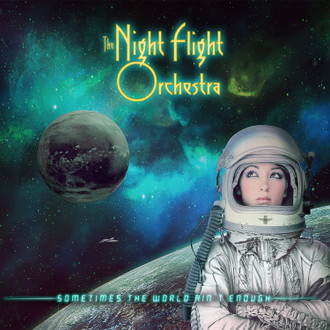
Despite featuring members of Soilwork and Arch Enemy, this is a long, long way from death metal, melodic or otherwise. Although the band’s first effort had a distinctly late-70s hard rock vibe to it, each record since has taken the listener deeper into the world of 80s AOR. Unlike a lot of the sterile, radio-friendly acts from that actual era, NFO bring a warmth and heartfelt approach that really brings the music alive. This is the band’s fourth album and probably their weakest, but it still stands well above the average album of 2018. Songs like “Turn To Miami” and “Pretty Thing Closing In” are immediate, timeless classics.
8. THE CROWN - Cobra Speed Venom

Although Deathrace King is still one of my top 5 death metal records of all time, The Crown never really were able to duplicate its genius. Cobra Speed Venom, however, comes damn close. It has all the brutality that the band is known for but brings back a lot of the punky/thrash energy and memorable riffs that have been missing for a while. The first three songs might be the best start to any album this year; just relentless, mayhemic brilliance. Top it off with one of the coolest and most original album covers I’ve seen in a while, along with three bonus tracks that are actually worth adding, and you have one hell of a return to form.
7. SAXON - Thunderbolt
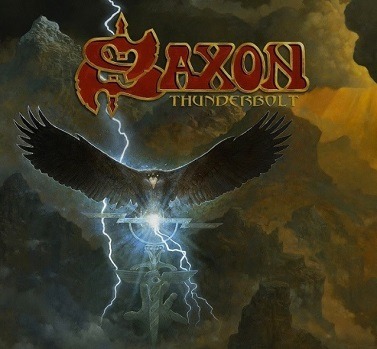
Saxon certainly made some missteps in the late 80s, but I can’t think of another band that has remained as true to form over the years, while also consistently putting out quality albums and touring relentlessly. Thunderbolt is no Wheels of Steel or even Call To Arms, but it is still a solid record that is as good or better than the last couple. From the melodic timelessness of “The Secret of Flight” to the moody “Nosferatu (The Vampire’s Waltz)” to the raging “They Played Rock and Roll,” there is also a diversity rivaled only by Priest on this list.
6. BLACK OATH - Behold the Abyss
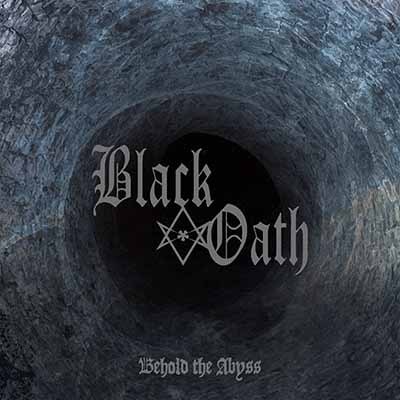
When it comes to true, epic, soul-crushing doom metal, Black Oath have become true masters. I have been following this band since the Portrait of the Dead single back in 2010 and am pleased to say they just keep going from strength to strength. Behold the Abyss balances a lush production, clean vocals, and plenty of melody, with dreadnought riffage and blissfully dark, esoteric lyrics. A rich, dynamic work of black art.
5. SIGN OF THE JACKAL - Breaking the Spell
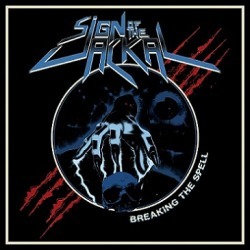
This amazing Italian band has created a style that is equal parts early 80s Warlock and late 80s Judas Priest. Great, driving metal tunes that sometimes border on speed metal with plenty of screaming solos and hooky choruses. The recording, the mix, the energy, everything about this record is incredibly old-school and authentic, right down to the 32-minute running time.
4. AUDREY HORNE - Blackout
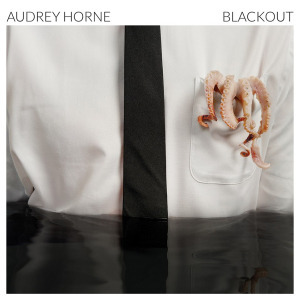
Ever since these Norwegian rockers abandoned all pretense and went full-on retro with their Youngblood album, I have been hooked. They compose hard-hitting rock tunes with tons of hooks and Lizzy-esque harmonies that give a nod to metal and punk without really being either. The first three songs - “This is War,” “Audrevolution,” and “Blackout” - are all perfectly built and give a great cross-section of the band’s diverse sound. Toschie’s vocals are as unique as his fashion sense and, as much as I loved the last two records, I think this one may be their best yet.
3. BRAINSTORM - Midnight Ghost
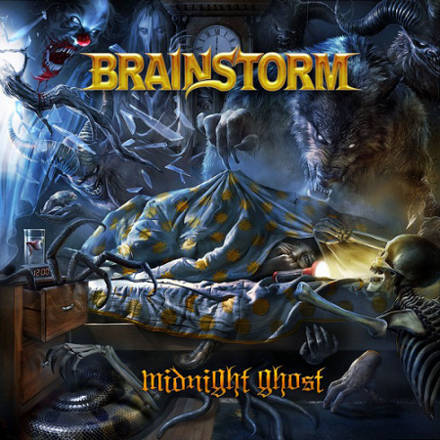
Brainstorm has long since perfected their style (as far back as Soul Temptation, some fifteen years ago), and each new release is really just varying levels of execution. As good as Scary Creatures was a couple years back, Midnight Ghost is truly brilliant and may possibly take the title as my favorite Brainstorm outing. All of the usual plusses are in place - great production, top-notch musicianship, catchy tunes - but the songs themselves are just a tad bit more finely honed and memorable. “Ravenous Minds” and “When Pain Becomes Real” in particular are killer and there is nary a dull moment here.
2. IMMORTAL - Northern Chaos Gods
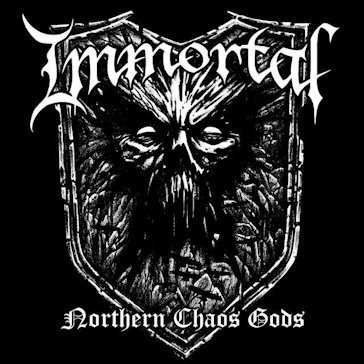
My first Immortal record was At the Heart of Winter and it is still my favorite black metal album, hands down. The combination of raw, icy riffs with the mind-blowing drumming and just enough melody to keep it all together was/is intoxicating. Immortal has never done a bad album, but some are definitely better than others and Northern Chaos Gods is one of the best ones. The ferocity is up there with Pure Holocaust and Demonaz’s vocals, while not quite as distinctive as Abbath’s, fit the music perfectly. The band wisely took their time to put this record together and the results speak for themselves.
1. JUDAS PRIEST - Firepower
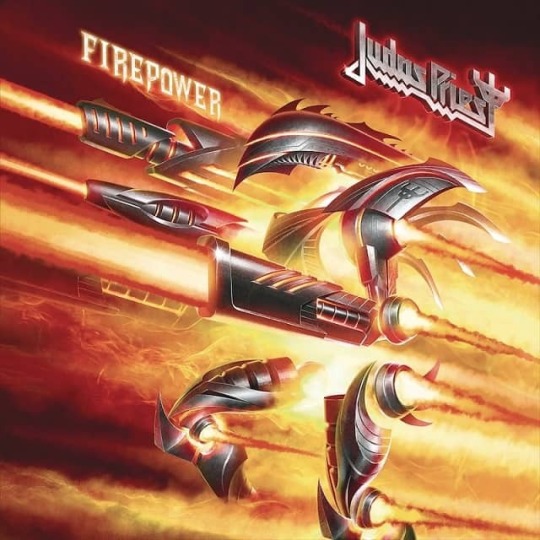
Priest has been one of my favorite metal bands since I first got into them back in ’82 and they are still right up there with Sabbath, Accept, and Mercyful Fate, with a catalog that is as diverse as it is brilliant. After the disappointing Nostradamus and good-but-not-great Redeemer of Souls, it was a real pleasure to hear Firepower, a true, all-guns-blazing Priest record. The production is 1000% better than anything they have released in the last two decades and the material is both diverse and top-notch. Songs like “Firepower,” “Never the Heroes,” “Children of the Sun,” and “No Surrender” have such a classic sound to them and Rob has not sounded this good since Painkiller. Even the weakest tracks (“Lone Wolf” and “Sea of Red”) have grown on me a bit, so I am confident that Firepower will go down in history as one of the band’s crowning achievements.
I must also mention some very impressive EPs, demos, and singles that were released this year, namely those from CIRITH UNGOL, ROUGH SPELLS, ÜLTRA RAPTÖR, PULVER, SIGNIFICANT POINT, TENTATION, ANCIENT SÉANCE, SABÏRE, and OCCULT BURIAL. If you aren’t familiar with any of these bands or haven’t heard their latest, I highly recommend getting acquainted immediately.
As usual, my list could have gone on much longer, but here are the bands that just missed the top 20: AMORPHIS, AURA NOIR, BEHEMOTH, BLACK REBEL MOTORCYCLE CLUB, BLACK VIPER, BLADE KILLER, CAULDRON, DIMMU BORGIR, DREAM CHILD, GOAT WORSHIP, GRAHAM BONNETT BAND, IRON ANGEL, KHEMMIS, KRISIUN, NIGHT VIPER, PRIMAL FEAR, PROFESSOR BLACK, RIOT V, SABOTER, SKULL FIST, SUBSTRATUM, TAD MOROSE, VISIONS OF ATLANTIS, VULCAIN, WHITE WIZZARD, WITCHFYRE, and WYTCH HAZEL.
What is on the horizon for 2019? Well, I am already psyched about the new ones from CANDLEMASS, DELAIN, ROCK GODDESS, FLOTSAM & JETSAM, CHAINBREAKER, SOILWORK, WITHIN TEMPTATION, MORTAL SCEPTER, HAMMERFALL, and TYTUS, plus possible releases from SACRED REICH, DEATH ANGEL, and EXCITER all have me really looking forward to the coming twelve months. The world is crumbling around us, but at least the metal scene is stronger than ever!
#best of 2018#judas priest#immortal#brainstorm#audrey horne#sign of the jackal#black oath#saxon#the crown#the night flight orchestra#haunt#leather#bullet#striker#abysmal grief#satan#witching hour#lucifer#artillery#perpetrator#burning witches
8 notes
·
View notes
Photo

Zadar introducing a new single release: The Upstairs Room
Menacing Post-Punk and darkwave aesthetics.
October 2020 - Zadar is a band with a focus on creating original music that blurs the lines between various genres. The group’s formula captures the angular darkness of post-punk, as well as the ethereal dreamscapes of shoegaze, goth, and darkwave. Their most recent single release is a song titled “The Upstairs Room,” which stands out as a hallmark of the band’s sound and identity.
The Furlong, Pa goth rockers create an edgy, aggressive sound. However, “The Upstairs Room” still retains a melodic twist, with catchy guitar parts and industrial-sounding drums. The song kicks off with a twangy guitar riff and a 16th note hi-hat pattern. The first few seconds of this track reminds me of acts like The Cramps, and I confess, I was kind of expecting a dark psycho-billy type song right after the twangy guitar intro! However, the song immediately takes a different turn, going for an earlier post-punk sound that stays true to the roots of the genre with no pretentiousness whatsoever. Eventually, it all falls into a reverb-drench post-punk stomper, in the vein of early Public Image LTD. or Jesus and Mary Chain. The song is based on the repetition of an ominous guitar riff, as the drums and bass drive the song relentlessly. The vocals are charismatic and haunting, perfectly matching the spirit of the song and the darker atmosphere of this release. The song feels like it is tipping the hat to the classic sounds of the genre - think 80s or early 90s. However, it is not just a trip down memory lane. On the contrary, it is an example of how this genre can be relevant and exciting in 2020 as well. The song has a minimalistic arrangement, as it is devoid of excessive studio trickery, in favor of treating the audience to a genuine portrait of what the band actually sounds like. In other words, this here is the sound of musicians playing their music together without mystifying the audience with excessive overproduction. The guitars are mostly performing leading phrases, going on the higher registers while the bass also fulfills a rhythmic role, almost like a very beefy rhythm guitar. The notes are simple and minimalistic, but just the perfect kind of patterns to really hold the song together and make it sound extremely punchy and tight. The vocals are drenched in saturation and echo effect, perfectly capturing the essence of the best post-punk and going for a theatrical flair that adds more vibe to the song as a whole. Today, it feels like many of the newer bands that label themselves as post-punk acts tend to veer more towards the dream-pop aesthetics of the genre, going for a rounder, ambiance-driven sounds rather than capturing the raw energy of earlier post-punk. What most people don’t get is that earlier post-punk was never just about pedals, reverb, or chorus effects. It was as fierce as the original punk wave, only spiced up with a more ethereal feel to it, which enabled these musicians to truly redefine the “rules” of what punk rock was supposed to be like. This was an open door to so many different ideas, and post-punk quickly became a crossroads, where bands could explore different directions and outlets. Zadar is one of these bands, and what they did with their sound is absolutely remarkable, keeping things simple and going for a “less is more” approach, but without needing to make any compromise when it comes to the depth and richness of their excellent music.
I would definitely recommend this one if you are a fan of artists like Dead Rituals, The Cure, as well as Joy Division, only to mention a few. Post-Punkers, Dark-wavers, and Shoegazers should jump on this one and don’t miss out on what Zadar is going to be putting out next!
Find out more about Zadar, and do not miss out on “The Upstairs Room,” which is currently available on the web.
Instagram: https://www.instagram.com/zzzadar/
Facebook: https://www.facebook.com/zadarmusic
Twitter: https://twitter.com/_Zadar
We also had the chance to catch up with the artist and ask a few questions: keep reading to learn more!
I love how you manage to render your tracks so personal and organic. Does the melody come first, or do you focus on the beat the most?
Answer: Thank you very much. I’m glad that came across because I like my songs to sound as natural and organic as possible. I’ve always thought of music as a very personal experience and a reflection of the artists’ soul and personality. I would say that for the most part, the melody comes first when I write. I usually just start jamming on the guitar until I come up with a riff that I connect with and would enjoy listening to as a fan. From there, I ‘ll usually write the rest of the guitar lines before moving onto the bass line and lastly, the drums. I’m a big fan of the Fender Bass VI and write most of my bass lines on it. Ever since I first discovered bands like the Cure and New Order, both of whom have utilized six string bass riffs in their songs, I’ve been enamored with its unique tone. I’ve also always been a fan of repetitive, single note type riffs. For example, Nine While Nine by The Sisters of Mercy is one of my favorite guitar riffs of all time.
Do you perform live? If so, do you feel more comfortable on a stage or within the walls of the recording studio?
Answer: At the moment, I do not perform live primarily due to the pandemic and the current state of things, as well as the fact that this project got started only a couple of months before lockdown started. I have performed for very small audiences in the past mostly comprised of family and friends and I plan on playing gigs once things start to go back to normal. I’m an introverted person so I would say that the studio is my comfort zone and a little more fun for me as an artist. I’ve always thought of myself as more of an artist than a performer but like I said, once we’re allowed to go to gigs again I will definitely play live because I’ve always loved seeing my favorite bands live and I’d hate to deny any of my fans of that experience.
If you could only pick one song to make a “first impression” on a new listener, which song would you pick and why?
Answer: Out of the two singles I put out so far, I would say that the current one, The Upstairs Room, would be the one I’d show a listener first. Not only because it’s the title track to my upcoming album, but also because I think it came out pretty much exactly how I imagined it and I think it’s slightly more representative of who and what Zadar is and what it stands for. The song has a dual meaning to it. The Upstairs Room is the room where I wrote most of my songs but it also represents the “room” or “space” in your mind where your thoughts, feelings, desires, regrets, memories of people from the past, etc., come from and how sometimes you can feel trapped in your own mind.
What does it take to be “innovative” in music?
Answer: I think to be innovative, you just have to be honest and make music that you enjoy making and listening to. The music an artist or band writes should be for themselves first and foremost. Pandering to the mainstream isn’t innovative because its already been done and you’re not being true to yourself. It’s just following the crowd which is something my musical heroes have never done.
Any upcoming release or tour your way?
Answer: Yes, I’ve been working on my debut album which I’m aiming for an early 2021 release. There will probably be another single in the lead up to the album. After which, depending on how things go with the pandemic, I would love to play some gigs, particularly in local Philly venues.
Anywhere online where curious fans can listen to your music and find out more about you?
Answer: Anyone who is curious about me or what I’m up to lately can check out my Instagram, @zzzadar, which is my go-to social media page. As for the music, you can find it on Bandcamp, Spotify, Apple Music, Amazon, and any other streaming services. I’d also like to take a moment to thank my fans and anyone who has checked out my music. This has been my passion for many years and it’s an honor to make music that people can relate to and resonate with.
0 notes
Text
Realme doesn’t like to waste time in introducing new phones. As a user, the more and better the options, the merrier! Even personally, I love every time I get some device to sink my teeth into. So as the novel 6 Pro reached my hands, I was quick to grill it. The fact that it’s been pushed as a spiritual sequel to the Realme X and not the Realme 5 pro made me all the more curious.
For a starting MSRP of Rs. 17,000, the phone brings a 90Hz dual-punch hole display, Snapdragon 720G, Android 10, and a 64MP quad cam. You may also view it as an alternative to Realme X2 where the AMOLED display has been swapped with a high-refresh-rate LCD panel.
While that ensemble sounds competent, one might wonder there gotta be some compromise, right? Well, there are some trade-offs, that I’ll bring to your attention. And by the end of the review, you’ll know whether you should buy the device or not.
So, C’mon, welcome to my review of the all-new Realme 6 Pro.
But, before we fire away, have a cursory glance upon the in-box contents and the spec table
Realme 6 Pro Unboxing
Here’s what you get inside the Realme’s signature Yellow packaging –
Handset
Charger
USB-C Cable
Sim Ejector tool
Protective case
User guide booklets
Realme 6 Pro Review: Price and Specifications
Model Realme 6 Pro Display 6.6-inch, 90Hz LCD, 1080 x 2400 (full HD+), Gorilla Glass 5, 400 Nits Brightness, 90.60% screen to body ratio, 400PPI Chipset Snapdragon 720G RAM 4GB/6GB/8GB LPDDR4x Storage 64GB/ 128GB UFS 2.1; Dedicated card slot (256GB) Software Android 10, Realme UI Rear camera 64MP F1.8 (primary); 8MP F2.3 (ultrawide-angle); 12MP F2.5 (20X Digital Zoom Telephoto); 2MP F2.4 (4cm macro) Selfie camera 16MP, F/2.0 + 8MP F/2.2 Fingerprint sensor Capacitive (Side-mounted) Dimensions and weight 163.9mm x 75.8mm x 9.4mm; 195 grams Battery 4300mAh, 30W fast charging Price
6 + 64 – Rs. 16,999
6 + 128 – Rs. 17,999
8 + 128 – Rs. 18,999
On with the review then,
Realme 6 Pro Review: Design and Display
Realme 6 Pro Review: Performance
Realme 6 Pro Review: Cameras
Realme 6 Pro Review: Audio, Battery and Connectivity
Realme 6 Pro Review: Verdict
Realme 6 Pro Review: Design and Display
While it’s distant relative OnePlus popularized the 90Hz refresh rate last year, Realme discounts that lubricity to less than one-third the price. The 6 Pro parades a large 6.6-inch display with FHD+ resolution and fluid responsiveness. But, that smoothness is bartered against AMOLED found on the Realme 5 series.
Upon a close probe, I realized this panel shares a plight worse than its peers. The colors are inaccurate and pale, even so, that Realme 6 (review) has a better display. Bizarre! ‘Tis even harder to notice when you’re outdoors.
The back has a familiar oblong with sensors and a realme logo linear to it towards the bottom. The camera To make things different, Realme 6 Pro sports a dynamic lightning texture at the back. That’s fancy to tote around!
The device is also easy to handle one-handed and fits comfortably in the palm. A lite profile even when its mostly glass build, save for plastic mid-frame. The left frame has the volume rocker and sim shelf, the right frame has a power key cum fingerprint reader and the base is where the phone’s solo speaker, USB-C port and 3.5mm jack resides. The buttons are easily reachable and responsive (even the fingerprint scanner).
So, let’s unlock it now!
Realme 6 Pro Review: Performance
I was looking forward to using this phone ever since I came to know it is running on the latest slice of Snapdragon – 720G.
Tasks like app-loading, multi-tasking, scrolling through Zuckstagram flew with ease. However once a while, the rectangle smart bloke did pause and ponder. Still, won’t label it a spoilsport. It garnered decent results on benchmarks and battlefields (PUBG) too. The battle royale game ran at 30 frames (not bad, not wow either) and here’s various other yardsticks data –
This slideshow requires JavaScript.
The performance is fueled by LPDDR4x RAM and UFS 2.1 in multiple configs to choose from. But, the real crowd-pleaser experience-wise would be Realme UI. And that’s a stark contrast in my opinion from ColorOS on Realme X and 5 Pro. If you go back to mine or any other reviews back in the days, the OS used to hold a place in the cons section. Not anymore!
ALSO READ: UFS 3.1 vs UFS 3.0 Comparison: What’s New and Different?
Android 10 treat and Realme’s own optimization trickery makes it one of the best software rendition in the Android world. A mix of my favs – Dark Mode (3rd party app-compatible), resizable windows, Digital Wellbeing, floating windows, game space, etcetera. That said, hey Realme, you can still let go of some things. A bevy of bloat and smart assistant, are, for instance, ghosts of ColorOS still haunting Realme UI. A personal opinion, yet it’s something worth quibbling.
The phone ships with the latest security update too. This is something left understated mostly but definitely confidence-inducing for the Android platform in general.
Speaking of which, dependable camera(s) is almost always a crucial criterion for a confident smartphone purchase. So,
Realme 6 Pro Review: Cameras
Click Click, you get two cameras on the front and four at the back. Won’t bore you by repeating the specs. Let’s jump straight into the real-day frames.
This slideshow requires JavaScript.
The 64MP Samsung GW1 sensor is a capable producer. The daylight shots below are beautiful with a respectable proportion of shadows, highlights, mid-tones, and sharpness.
This slideshow requires JavaScript.
I have observed a shift in the green hue amid normal and ultrawide snaps. Rest, let the photos talk for themselves.
This slideshow requires JavaScript.
Details are sketchy once you go all in. But, frankly, having varied sensors is in itself a big shot. Here, they are serviceable.
Despite the night, the cameras manage to pull some genuine good shots. Nightscape piques the colors and along with it, comes some noise. Look at grains on the sky in the image below.
This slideshow requires JavaScript.
Here are few more Nightscapes from the Realme 6 Pro –
This slideshow requires JavaScript.
Moving to macro, the last sensor of the lot can capture details as close as 4cm. The results were passable.
This slideshow requires JavaScript.
Bring in some humans to the fore and the camera won’t disappoint, although the dynamic range needs work. The portrait shots are worth sharing on social media. But, the blur can look a bit unnatural. The good thing is the presence of a slider to adjust the background bokeh.
#gallery-0-32 { margin: auto; } #gallery-0-32 .gallery-item { float: left; margin-top: 10px; text-align: center; width: 50%; } #gallery-0-32 img { border: 2px solid #cfcfcf; } #gallery-0-32 .gallery-caption { margin-left: 0; } /* see gallery_shortcode() in wp-includes/media.php */
And that’s a good thing about the camera UI. Scroll and you’ll find ample options to toy around. You get options like Time Lapse, Slo-mo, Panorama, Expert mode, full-64MP mode, and ultra-steady clips up to 4K@30fps.
Realme 6 Pro Review: Audio, Battery, and Connectivity
The sound outta the solo speaker at the foot is as secluded and soft as you would expect. But, for what it’s worth these days, Jack is here! So put on your cans or in-ears to enjoy the content. Or else go cordless and you’re backed by Bluetooth 5.1 and associated codecs (AAC/APTX/APTX-HD). Go gaga!
Sitting in between the grille and hole is a USB-C socket. That’s where you dock the in-box 30W fast charger. Yes, if the 4300 mAh juice bank drains out, it can refill to 100 in an hour. Back to zero can easily take you through a regular day! Even if you push the device to limits, that charger is liberating to have.
Amongst other things, the phone bags ISRO’s NavIC navigation system out of the box. It’s not something we could explicitly test. Nevertheless, theoretically speaking, that’s better location accuracy in congested urban areas.
Oh, yeah calls were okie-dokie. No problem whatsoever. But, let’s cut the call now as its time for the final say.
Realme 6 Pro Review: Verdict
You see Realme 6 Pro has a lot of features going for it. The dual-punch-hole is a pleasing change from the cookie-cutter notches of yesterdays. Even though the plastic part does cheapen the build ever-so-slightly. Then there is functional and feature-filled software, reliable optics, and the rest of its performing hardware.
And by now you know that the weak sauce is that display. I hope it can be fixed by some tuning. Cuz, if not, that’s a killjoy for sure!
So, yeah, a better display and speaker output would have done wonders. But beyond that, if you love a good bargain just like the next guy, this my friend is an amazing value for money.
Pros
Reliable cameras
Feature-rich software
Covers essential connectivity options
30W fast charging backs an already huge battery
Snappy biometrics
Cons
Display quality
Mediocre audio output
Realme 6 Pro FAQ
Q. Does Realme 6 Pro offer Gorilla glass protection?
A. Yes, the Realme 6 Pro display is shielded by Gorilla Glass 5.
Q. Is the Realme 6 Pro water-resistant?
A. No, the Realme 6 Pro is not water-resistant.
Q: Does the Realme 6 Pro support NaVIC?
A: Yes, the Realme 6 Pro supports ISRO’s NaVIC. Find more about it here.
Q. Is there a notification LED on the Realme 6 Pro?
A. No, the Realme 6 Pro doesn’t have a notification LED light.
Q. Is there an IR blaster on the Realme 6 Pro that can be used to control TVs and other devices?
A. No, there is no IR blaster on the Realme 6 Pro.
Q. What is the AnTuTu score of Realme 6 Pro?
A. In our test, Realme 6 Pro 5G scored 283254 points in the AnTuTu benchmark.
Q. Does Realme 6 Pro support MicroSD card storage expansion? Is it a dedicated slot?
A. Yes, there is support for dedicated expandable storage up to 256GB.
Q. Is there Widevine L1 support on the Realme 6 Pro for HD playback on Netflix, Amazon Prime Video, etc?
A. Realme 6 Pro has DRM Widevine L1 support and is HD streaming ready. However, as of now, I couldn’t run Netflix and Prime Videos at HD quality.
Q. Does Realme 6 Pro support wireless charging?
A. Unfortunately, no Realme 6 Pro doesn’t support wireless charging. So, that lack of reverse wireless charging goes without saying.
Q. Does Realme 6 Pro support call recording?
A. Yes, Realme has baked in an automatic call recording feature in the Realme 6 Pro. Find this option hidden within System apps> Calls> Call recording.
Q. Does the Realme 6 Pro support USB OTG?
A. Yes, you can connect the external pen drive to the Realme 6 Pro using the USB OTG feature.
Q. Does the Realme 6 Pro support NFC?
A. Yes, Realme 6 Pro does support NFC.
Q. Does the Realme 6 Pro support aptX codec?
A. Yes, Realme 6 Pro does support the aptX codec.
Q. Does the Realme 6 Pro support VoWiFi?
A. Yes, Realme 6 Pro does support the VoWiFi.
Q. Does Realme 6 Pro support Camera2API and Google camera app (GCam)?
A. Realme 6 Pro comes with Level 3 Camera2API support out of the box and thus, GCam should work just fine.
Q. Does Realme 6 Pro support FM Radio?
A. Yes, the Realme 6 Pro does support FM Radio.
Realme 6 Pro Review Realme doesn't like to waste time in introducing new phones. As a user, the more and better the options, the merrier!
0 notes
Text
21 books you need to read this spring

Spring is here and that can only mean one thing: time to shake yourself out of hibernation and bust out that spring reading.
But with so many great books coming out in 2018, it can be hard to figure out just which ones you should pick up.
SEE ALSO: 9 books to read before seeing the movie
Don't worry though — The MashReads Podcast has got you covered.
This week on the MashReads Podcast, we are joined by Cristina Arreola, books editor at Bustle, to chat about spring reading. Join us in the episode below as we talk about the books we've read recently, the books that've been on our spring reading wishlist, the classic books we've been revisiting, and the upcoming books you need to know about.
Here's the podcast — read on for our list of 21 books you should check out this spring further down the page.
As always, we close the show with recommendations:
Martha recommends Kali Uchis’ new album Isolation. “I feel like it got lost in the Cardi B / Drake wave that happened. Her music is just this beautiful fusion of a bunch of different genres like jazz, pop, rock, and her voice is wonderful, and the features that are on the album are fantastic. You have everyone from Jorga Smith to Tyler, the Creator to Steve Lacy. It’s just a perfect album to anticipate spring and summer with.”
Cristina recommends Radiolab’s "Border Trilogy," a three part series on the border U.S./ Mexico border. “If you’re interested at all in the immigration debate, this series a really good primer and delves deep into it.” She also recommends Francisco Cantú's The Line Becomes A River, a memoir about Cantú's experience growing up on the border and working as a border agent. “It’s just really heartbreaking and it’s not polemic and it just humanizes the issue in a way that I think is really necessary.”
MJ recommends the Twitter account Modern Glee (@Glee_2018), which imagines the television show Glee would look like if it still existed in 2018. “It reaches these ridiculous peaks the show actually did when it was airing.”
Cristina also recommends a tweet of a hilarious photo from a maternity photoshoot with Ronnie from Jersey Shore “It’s one of the funniest thing I’ve ever seen.”
Also mentioned on the podcast: 'The Rosary,' an essay by Alexander Chee about becoming a rose gardener.
Be sure to check out more of Cristina's work by checking out Bustle's books coverage.
21 Books you should be reading this spring

Image: Penguin Press
Little Fires Everywhere
Celeste Ng
Celeste Ng's Little Fires Everywhere is a study in the beautiful chaos that can be found within even the most controlled communities. The book opens with a house burning down and then flashes back to explore how we got there, revealing the dual plights of the Warren family struggling to fit in the tiny suburb of Shaker Heights and the Richardson family struggling to maintain the illusion of perfection, and just what happens when those two families intersect.
Recommended by: MJ "That book escalates so much and so quickly."

Image: Little, Brown and Company
The Recovering: Intoxication And Its Aftermath
Leslie Jamison
Empathy Exams writer Leslie Jamison is back with new non-fiction book The Recovering, part memoir about recovery, part deep dive into alcoholism, and part criticism of the way we talk about addiction.
Recommended by: Cristina. "It is probably one of the most comprehensive accounts of alcoholism that has ever been written. But it’s also so human, and her perspective on love and her own insecurities and family are so incisive and so relatable. It’s such a stunning book."

Image: Penguin Books, Limited (UK)
Another Country
James Baldwin
Sometimes you just gotta go back to the classics. If you're looking to revisit a book this spring, check out James Baldwin's portrait of New Yorkers in the '50s Another Country.
Recommended by: Martha. "My heart aches for all of the characters and all of their struggles and the lives that they lead in New York. James Baldwin is, obviously, one of the greatest writers to have ever walked this planet."

Image: Riverhead
New People
Danzy Senna
New People is a 2017 gem that may have slipped through the cracks of your reading list. The novel tells the story of Maria, a biracial woman who has what on the surface seems like a perfect life. But when she becomes obsessed with a young poet, Maria makes a series of choices that could destroy the semblance of happiness that she's worked to build.
Recommended by: Martha. "That book. I still think about that book. It’s super short, you’ll breeze through it. It’s fucking creepy in the best way. The character is so interesting and creepy, which is the only word that comes to mind. But also there’s so much I relate to."

Image: Penguin Press
Winter
Karl Ove Knaausgard
Sure, spring is here but Karl Ove Knausgaard's Winter will make you feel immediately nostalgic for the cold season. The book is a series of meditations about life, written as a tribute to Knausgaard's unborn daughter.
Recommended by: MJ. "Hearing Knausgard take his signature brooding meditations and apply it to stuff that we can all relate to like “snow” or “winter”… I’ve loved diving into them."

Image: Riverhead
The Female Persuasion
Meg Wolitzer
The Female Persuasion tells the story of Greer Kadetsky, a college student who, after a chance run-in with feminist icon Faith Frank, begins a career at a feminist magazine. But as the book bounces from the perspectives of Greer, her friend Zee, her mentor Faith, and her boyfriend Cory, The Female Persuasion explores what it means to advocate for women and the human struggles behind the fight for gender equality.
Recommended by: MJ. "I keep describing it as a feminist manifesto disguised as a coming-of-age novel. Meg Wolitzer drops gospel truth in this book."

Image: Algonquin Books
An American Marriage
Tayari Jones
An American Marriage is an exploration of race, privilege, and love. The book follows newlyweds Celeste and Roy. But when Roy is arrested for a crime he didn't commit their love is shattered. What follows is a beautiful novel about love and the ways people drift apart.
Recommended by: Cristina. "It is phenomenal. It is wildly good. It’s super painful to read, especially if you love love, but it’s just so beautifully written and I couldn’t stop reading it."

Image: Little, Brown Books for Young Readers
The Astonishing Color of After
Emily X.R. Pan
The Astonishing Color of After is a, well, astonishing juggling act of grief, art, family, history, and mental health. The book tells the story of Leigh Chen Sanders, a young artist who is reeling after her mother dies by suicide. But when Leigh begins seeing a bright red bird that she believes to be her mother, Leigh and her father takes it as a sign to go to her mother's home in Taiwan. Once there Leigh not only explores her own grief, but also dives into her family's history, and the ghosts that are still with them all.
Recommended by MJ and Cristina. Cristina says: "It is unbelievable. It’s unfair. You read it and you’re like this shouldn’t be able to come out of your head."

Image: Grove Press
Freshwater
Akwaeke Emezi
Akwaeke Emezi's Freshwater follows Ada, a Nigerian woman who hears voices because she has been born "with one foot on the other side." The novel is narrated by a collection of those voices as each of Ada's fractured selves fight for control over Ada, resulting in a powerful and surreal look into the human mind and the way we grapple with our identities.
Recommended by: Martha

Image: Henry Holt and Co.
The Parking Lot Attendant
Nafkote Tamitrat
The Parking Lot Attendant is a coming-of-age story about a girl in Boston who falls in love with Ayale, an Ethiopian parking lot attendant who is "the unofficial king of Boston's Ethiopian community." The book starts out at the end, showing our unnamed narrator as an outcast on an undisclosed island with her father. But after this brief glimpse into the future, the book flashes back to the past, exploring the narrator's teenage years, her complicated relationship with her parents, her love for Ayale, and the way that she gets wrapped up into Ayale's increasingly complicated schemes.
Recommended by: Martha

Image: Scribner
Sing, Unburied, Sing
Jesmyn Ward
Sing, Unburied, Sing is a moving portrait of family and history. The book follows Jojo and his mother Leonie as they road trip to pick up Jojo's father from prison is Mississippi. But as they journey, they are haunted by the ghosts who have stories to tell about the South, race, growing up, and the history that shapes us all.
Recommend by: Martha

Image: Graywolf Press
The Argonauts
Maggie Nelson
If you're looking for a deep dive into love this spring, make sure to revisit Maggie Nelson's 2015 book, The Argonauts. The book is a memoir about Nelson falling in love with her partner Harry Dodge, a gender-fluid artist. Told with Nelson's signature poeticism, the book is an expansive look at the experience of falling in love and starting a family, as well as an exploration of how we talk about sexuality, gender, marriage, and more.
Recommended by: Martha

Image: Counterpoint
Heart Berries
Terese Marie Mailhot
Heart Berries is a coming-of-age memoir about working through trauma. Through the book Mailhot explains her experience being hospitalized and diagnosed with PTSD and bipolar II disorder, and confronting the family and relationships that shaped her. Speaking to Bustle, Mailhot explained, "I think Heart Berries is a conjuring. It is some type of incantation where my mother becomes a god and the men who hurt me falls away."
Recommended by: Cristina.

Image: Simon & Schuster
Asymmetry
Lisa Halliday
Lisa Halliday's Asymmetry tells two stories side-by-side: the tale of Alice, a young editor who begins a relationship with older and famous writer Ezra Blazer as well as the plight of Amar, an Iraqi-American man who is detained by immigration offers as he tries to visit his brother. "Asymmetry poses questions about the limits of imagination and empathy—can we understand each other across lines of race, gender, nationality, and power?" the New Yorker asks.
Recommended by: MJ

Image: Mariner Books
How To Write An Autobigraphical Novel
Alexander Chee
From literary force Alexander Chee comes a new essay collection about art, sexuality, activism, love, and more. Part memoir detailing Chee's own past (relationships, experiments in rose gardening, etc) and part collection of writing advice, How To Write An Autobiographical Novel is an unforgettable book about how love and writing shape us.
Recommended by: MJ. "He has an essay called 'After Peter,' and it is easily one of the most affecting essays I've ever read in my life. I read this book a little while ago and I've just been waiting for it to come out so I can talk to people about it. It's so good."

Image: Random House
Green
Sam Graham-Felsen
Sam Graham-Felsen's novel Green turns to the past to explore the present. The book explores race and privilege as we follow David Greenfield, one of the few white kids at Martin Luther King, Jr, Middle School in Boston in 1992. After David meets Marlon Wellings, a black kid who lives in a public housing project near Dave's own gentrifying neighborhood, the two strike up an unlikely friendship. But as they begin spending more time with each other, they begin to interrogate the difference between the privileges each is afforded.
Recommended by: MJ

Image: Tor Teen
Anger Is a Gift
Mark Oshiro
In his debut novel Anger Is A Gift, Mark Oshiro shines a light onto police brutality, community, and the way we stand up to systemic oppression. The book follows Moss Jeffries, a teenager in Oakland reeling from the death of his father who is killed by a police officer and then vilified by the media. Six years later, during his junior year of high school, Moss and his friends begin protesting the Oakland police after facing constant intimidation in their school. But after a protest that goes awry and tragedy strikes, Moss must learn what to do with the anger that has been building up inside him.
Recommended by: MJ

Image: Ecco Books
The House of Impossible Beauties
Joseph Cassara
Joseph Cassara's The House of Impossible Beauties is a novel so beautiful it's hard to believe it's a debut. The book follows a cast of characters who are all navigating New York City's LGBTQ and drag culture of the '80s and 90s. But, as you meet each narrator, the book reveals the raw, heartbreaking stories behind the glamor we associate with the ballroom scene.
Recommended by: MJ

Image: Hogarth
The Pisces
Melissa Broder
If you loved The Shape of Water, be sure to check out Melissa Broder's The Pisces. The book follows Lucy, a PhD student who has been writing her dissertation for nine years. When Lucy and her boyfriend break up, she visits her sister in Los Angeles for the summer — where she falls in love with a merman.
Recommended by: Cristina. "It's fucking great. If you love love, you'll love it."

Image: Riverhead
The Ensemble
Aja Gabel
Aja Gabel's The Ensemble is a deep dive into the inner lives of musicians. The book follows four friends and examines their relationship to each other, as each tries to navigate the world of music as they grow up. The result is a beautiful novel about friendship, art, and the way we pursue our passions.
Recommended by: Cristina.

Image: Riverhead
The Incendiaries
R.O. Kwon
If there is a novel that goes to unexpected places, it's The Incendiaries by R.O. Kwon. The book tells the story of Phoebe Lin, a Korean American student who is grieving the death of her mother and becomes increasingly drawn to an extremist cult, and her fellow student Will Kendall, who is confronting his fundamentalist upbringing. After the cult bombs several buildings, Phoebe goes missing and Will begins a search to find her and to get some answers.
Recommended by: Cristina. "Phenomenal. Very quick read."
WATCH: Here's 5 tips for Spring cleaning your digital footprint

#_author:MJ Franklin#_lmsid:a0Vd000000DTrEpEAL#_uuid:601d6b6b-ffdb-36b6-81c8-ea69abb70b58#_revsp:news.mashable
0 notes
Text
Impressions: Adventures in Mythos London #1
We recently decided to play ourselves some Call of Cthulhu. I had the Cthulhu Britannica: London boxed set lying around ever since I got it from the Kickstarter, and it was time to do the unholy act of breaking the seal... the boxed set looks fine. I already had prepped myself by reading the PDF but now at the gaming table we actually got the books out. It’s always an experience of wonder, opening a boxed set, but I would say it’s good these books came in a box. They’re rather thick softcovers and I think they would not look so good on a shelf by themselves. While it’s time to nitpick: The covers do not tell me which book is which. They just have the same front page in different colors. The actual title is on the spine. Not very practical in a boxed set since I have to get each out and read the spine. That works better if you put them on a shelf.
It’s nice to see them in print. I like glossy paper. The combination of glossy, coated paper and the softcover will always seem a bit cheap in comparison but the box gets you a lot of content for a fair price.
One thing I ran into which I wasn’t quite prepared for was the step over to 7th edition. I understand that a publisher goes for the newest edition when pushing a new product. Which sane businessman wouldn’t? I think Chaosium dropped a bit the ball there. Not with the content, I’m not criticizing that. But with the ease of conversion between editions. You basically have to own the newest edition and I simply don’t right now.
You see, An Investigator’s Guide to London gives you the sample occupations for 7th edition and I went to the net for a mapping between 6th and 7th edition skills. It seems that there is a conversion guide in the 7th edition’s Keeper Rulebook. I found fan-written explanations of what changed in 7th edition but I did not find more straightforward conversion notes. (Like: These are the new skill names and these are their old equivalents. I just found reviews of the new edition but on short notice I did not unearth the kind of exact mappings you need to do this on-the-fly.) I finally admitted to myself that my Google-Fu was not cutting it in time for saving gaming night, so we reverted to the 6th edition and its occupation list.
Again, to be fair, the whole Mythos London affair contains stat blocks and notes for 6th edition. But not in the occupations chapter which to me would have been the most important part. This would have been the time to shine on the verge between editions by simply dual-statting the occupations. Alas, it was not to be...
So, we did character creation finally in 6th edition with players trying to map their character concepts to the more generic strokes given in the rulebook. On to the adventure itself!
I was running Terror on the Thames and from this point on there will be definite spoilers, reader beware.
The scenario is very upfront about its nature by stating it’s very linear to make it easier for people playing for the first time. That’s all fine and dandy, but I think the scenario is neither easy to run for a beginner Keeper nor does its linearity do it credit.
The initial sequence is a cocktail party with more than 3 dozen NPCs to interact with. This would be a challenge for any game master. I managed quite well but at some point the players tired of being asked similar small talk questions like “What do you do?” and so on because I was running quite a bit of the cast by them. The good part is that this gives the players all the more reason to care about these people, all the more important for a horror scenario. It also helps you to flesh out your new character as answering these questions requires by the players to come up with details. That was a fun experience.
Many rough edges came to light as well. First of all, many characters have secrets described about them but that doesn’t necessarily tell you how to roleplay these NPCs at a party. Yes, he is a murderer and anxious to please, but is that enough to play him at a party? A few solid areas of interest to guide the chat would have been more worthwhile. Also, for some unrealistic reason all the characters were aged rather young - even looking younger than their respective portraits. Given it’s a society function an age range from the 20s to 60s would given more color to it. Right now it’s all rich heiresses and gigolos and a few boring people in between. It is really unlikely that London’s most important collector of occult literature is below 30, really. (Were they rolled from a character creation tool maybe? After all, it’s a lot of stats to make.) I had to add personality to most of them, like deciding that the actual jewel thief is a sassy one liking to poke fun at the men in the group.
The given format would be more appropriate to a murder mystery where the backgrounds of the people at the party matter as you will interact with many of them in turn to find the true murderer. Unfortunately you can do nothing about the fate of almost all of these people because it’s a complete railroad. Who dies or lives is already decided. Also, most of the background details will be revealed during the second stage of the adventure when the characters find most of the people slaughtered already. They can save a few hostages at this stage and one or two straggling survivors. But practically all information given during the party consists of red herrings. And so are most clues to be found on the boat after everybody falls unconscious at the same time. (The true mark of a railroad: Absolutely inescapable plot points.)
So, the PCs awake without their items in a locked cabin they have to break out of. (What happens if they fail their rolls to do so or are not muscle-bound is up to the Keeper. Yay for rolls that can stall the plot!) Why they were locked up instead of becoming monster fodder makes no sense in the story, but it keeps the adventure going. We also never really learn why the plan of the cultists fails. They wanted to feed the guests to a monster, the monster feeds and then gets obsessed with hunting down the head cultist. Instead of feeding all guests to the monster he keeps some hostages - to what avail? How does it ensure survival? All this does is give the investigators a goal but that’s it.
They can also not stop the rigged boilers from exploding the whole ship. Woe on the Keeper who has someone on their crew that invested points into skills like “Operate Heavy Machinery” or a technical skill because this railroady plot point makes little sense. Break one pressure bearing pipe and the damn thing will not explode. The explosion is only there to force players into the third act. Because else they might never learn there are survivors who did not simply take off in the dingy or jump overboard. They have to railroaded onto the island location so they can finish the adventure.
In the final location they are forced into a confrontation with the Mythos creature by no real fault of their own. If they’re unlucky they get killed now and the cultists get away or a free pass. There’s not much the book foresees except using stealth to get away from this. I intend to run that scene differently and confront the players only with the creature as it fights off the cultists’ servitor zombies to get at the cult leader. This way it’s a multi-sided battle and interesting choices can be made. At least that scene is sketched out. It’s best to simply ignore the adventure notes before that, including notes of how you need rolls to not slip in the mud.
They said it’s linear. But frankly, it makes no sense. It has almost no player agency. There’s very little to achieve most of the time. You can roam around the boat having a haunted house experience. Experienced players will probably find the whole experience tiresome. And whenever the players do not have the full picture, I tend to think red herrings are superfluous or dangerous as they distract most groups too much that already have trouble piecing things together. A flood of irrelevant clues is one of the worst things in any adventure knowing what it does to players. I often have to stop play and make them sort through the clues to get a better picture. This should not be required in a short, linear scenario.
Also: The scenario relies pretty much on combat for a resolution. The scenario ensures you can’t run away. It also has no clever gimmick to make you beat the monster or get away another way. Given that this is a regular day in London, however, you might just jump into the Thames and try to be picked up by any passing boats, really. As I said, it makes not much sense.
And besides the last location nothing much about it is particularly “londoney.” It introduces one real location and is elsewise could be set in the US just as well, with none of the trappings changed.
I ran the dinner party last Wednesday. I did not open the second act yet. I’ll write up how that actually goes when it comes to play.
0 notes